Exploring Topaz: The November Birthstone's Allure


Intro
Topaz, a gem that seems to dance between a myriad of colors, holds a special place among gemstones. For those born in November, it embodies not just beauty but also an array of historical and cultural significance. This piece aims to guide you through a journey of topaz’s allure, touching on its various facets, from its dazzling hues to its storied past. Whether you're a seasoned collector or someone intrigued by the gemstone world, there's something here for you.
Gemstone Overview
Definition of Gemstones
Gemstones are naturally occurring minerals that have been cut and polished for decorative purposes or for making jewelry. They are valued not only for their beauty but also for their rarity and durability. Topaz belongs to this illustrious group, showcasing a unique spectrum of colors that attract many.
Classification of Gemstones
Gemstones can generally be divided into two classes: precious and semi-precious. (In modern classifications, the lines can sometimes blur.) Precious gemstones are typically rare, and their value is often dictated by demand and market trends. Topaz, while often regarded as semi-precious, can also reach precious status, particularly in certain variants like the Imperial Topaz, which displays a rich, golden hue.
- Colors of Topaz:
- Blue topaz: Known for its clarity and brightness.
- Imperial topaz: Exhibits shades ranging from golden yellow to pink.
- Clear topaz: Labeled as 'white', this is often used as a diamond substitute.
- Mystic topaz: Enhanced varieties that showcase iridescent colors.
Historical Significance
Origins of Gemstone Use
Historically, gemstones have been utilized not just for adornment but also for their believed metaphysical properties. Topaz, particularly, has been cherished across cultures as a symbol of clarity and strength. Ancient civilizations attributed many virtues to topaz, ranging from protection against harm to the promotion of wisdom in its wearer. Thought to harness solar energy, topaz was often associated with light and joy.
Cultural Insights: Gemstones in Ancient Civilizations
In ancient Egypt, topaz was thought to be the stone of the sun god Ra, providing warmth and protection. Moreover, throughout the Middle Ages, it was popular among royalty and served as a talisman against anger and sadness, showcasing its varied roles across time.
The admiration for gemstones transcends mere aesthetics; they have been woven into the very fabric of cultural, spiritual, and emotional narratives of humanity.
Prologue to Topaz
Topaz, a striking gemstone often associated with warmth and light, plays a significant role in the realm of birthstones. Its allure lies not just in its vibrant hues but also in its rich historical context and numerous attributes. Understanding topaz sets the stage for appreciating its role as November's birthstone, a gem celebrated for its beauty and deeper meanings.
The exploration of topaz encompasses several key aspects. First, it is essential to grasp what topaz truly is in terms of its composition and properties. This understanding helps appreciate why it is cherished not only for decorative purposes but also for its unique characteristics. Moreover, recognizing topaz's status as the birthstone for November enriches the significance it holds for those born in this month.
As we dive into the specificities of topaz, we will encounter its diverse color variations, its symbolic meanings, and its place in history and craft. The discussion will allow gemstone enthusiasts and collectors alike to grasp the multifunctional value of topaz, whether in jewelry or in cultural practices. With these insights, readers will be prompted to reflect on their personal connections to this gem and its broader significance.
Definition of Topaz
Topaz is a silicate mineral, primarily composed of aluminum and fluorine, forming under high-temperature conditions in igneous rocks. Often appearing in shades of golden, blue, pink, and even colorless, topaz displays a remarkable versatility in color that appeals to many. When we talk about pure topaz, it showcases a glassy luster and can be very transparent.
This gemstone is not just a visual delight; it has a hardness of 8 on the Mohs scale, making it quite durable. Such traits enable topaz to withstand the rigors of everyday wear, which is crucial for jewelry makers and wearers alike. Additionally, topaz can exhibit different optical phenomena, such as pleochroism, meaning it can show different colors from different angles. This quality adds another layer of intrigue to this captivating stone.
Topaz as a November Birthstone
Topaz holds the distinct honor of being November's birthstone. This connection brings with it a host of traditional meanings and beliefs. For those born in this month, topaz symbolizes strength, wisdom, and protection. It is often associated with the idea of enhancing positive energy and dispelling negativity, an enchanting concept that resonates with many.
In terms of cultural significance, topaz has been revered over centuries. Ancient civilizations often considered it a stone of healing, even thought to bring good fortune to its wearer. From royal crowns to modern jewelry, this gem has adorned many esteemed individuals, each reflecting its historical importance.
Moreover, various forms of topaz have found a place in birthstone traditions around the world. For example, in the Ayurvedic tradition, topaz is believed to have healing properties that encompass both physical and emotional well-being. Such beliefs emphasize how this gemstone transcends mere aesthetics and enters the realm of holistic practices.
Including topaz in personal collections or gifting it to those with November birthdays can thereby carry more sentiment than just the beauty of the stone; it offers a tangible connection to cultural heritage and personal significance.
Historical Significance of Topaz
The allure of topaz goes beyond its beautiful colors and durability; this stone has a rich tapestry woven through history. Understanding the historical significance of topaz enriches not just the appreciation of the gem, but also illuminates how cultures across the globe have held it in high esteem. From ancient civilizations to modern trends, knowing the story behind topaz can be just as intriguing as wearing it.
Ancient Uses and Beliefs
Topaz has a storied past that stretches back millennia. In ancient Egypt, it was believed that topaz was colored by the golden glow of the sun god Ra. The Egyptians utilized this stone not just for jewelry but also for its perceived metaphysical powers. They often carved it into charms or amulets, believing it to bring protection and strength. Topaz was thought to ward off harm, especially for warriors going into battle.
"Topaz has held a significant place in human culture, symbolizing power and protection that transcends generations."
In ancient Greece, the reverence continued. The Greeks named it after the Greek word "topazios," from the island of Topazos in the Red Sea, where the stone was mined. Believers of this time thought it could increase strength and even enable users to see into the future. The Romans also valued topaz highly, believing it to possess the power to heal both physical and emotional ailments.
Moreover, the Middle Ages saw topaz in a different light. The stone was often considered a talisman, thought to bring clarity to the mind and tranquility to the spirit. Many wearers wore it as a symbol of love and fidelity, making it a favorite among the aristocracy of that era. Its associations with wisdom and harmony led to its use in various ceremonial items and royal crowns across Europe.
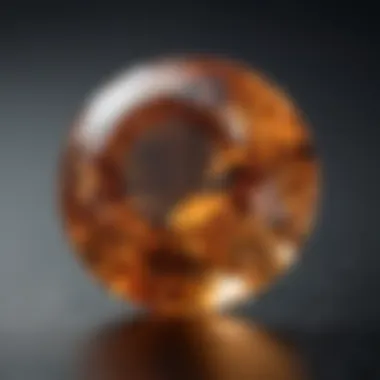
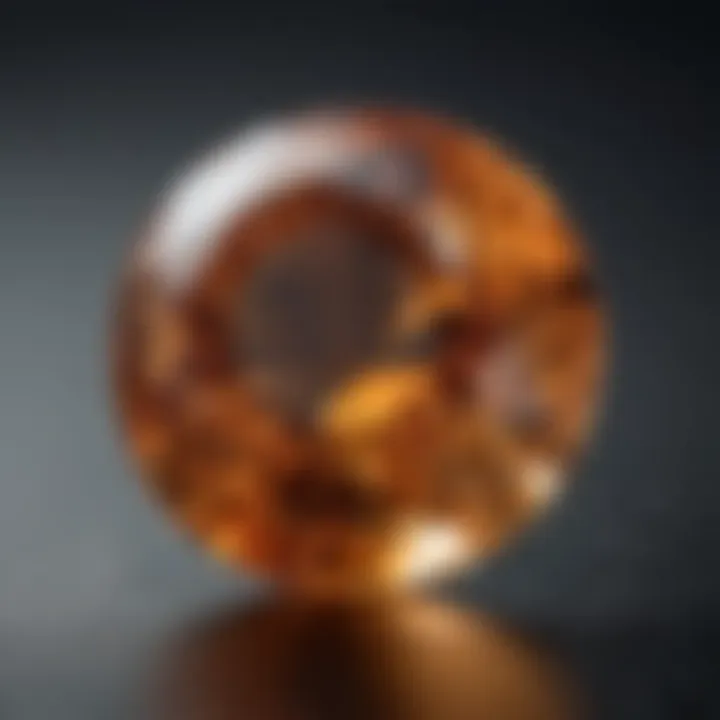
Topaz in Different Cultures
Different societies have interpreted the significance of topaz uniquely, showcasing its universal appeal. In Indian culture, for instance, topaz is often linked with the divine and is a symbol of love and affection. Many still believe that it promotes calmness and peace of mind, making it a popular stone in traditional Indian jewelry. Some even suggest that wearing topaz can invite prosperity.
In Tibetan traditions, topaz is often used in meditation practices. Here, it is considered a spiritual stone that aids self-reflection and enhances intuition. Often, the gem is included in mandalas, intricate designs used for meditation and representation of the universe.
Furthermore, certain Native American tribes consider topaz to be a stone of the Earth, deeply connected to the energy and spirit of nature. It symbolizes balance, calm, and harmony with the natural world, reminding wearers to stay grounded.
This spectrum of uses and beliefs underscores topaz's rich heritage—each culture adding layers of meaning that contribute to its historical significance. Today, as gemstone enthusiasts and collectors explore topaz in their own contexts, they also participate in an ongoing dialogue with the past, celebrating this gem’s vibrant history.
Geological Formation of Topaz
Understanding the geological formation of topaz gives significant insight into its value and characteristics. Topaz is not just a dazzling gem; it is a product of geological processes that have taken millions of years to unfold. Its formation involves both mineralogical aspects and source geography, which helps in appreciating why this stone holds such a prominent place in both nature and culture.
Mineralogy and Composition
Topaz is primarily composed of aluminum silicate fluoride hydroxide. Its chemical formula can be simplified to Al₂SiO₄(F,OH)₂. This unique composition gives topaz its physical properties, including its hardness and ability to form various colors. The presence of trace elements, such as iron, chromium, or vanadium, can alter its hue, which is why topaz can appear in shades ranging from clear to blue, yellow, pink, and even colorless.
Particularly fascinating is the crystal structure of topaz. It typically forms in an orthorhombic system, which means it has a distinct three-dimensional arrangement of atoms. This feature not only influences the durability of the stone but also contributes to its brilliance. With a hardness rating of 8 on the Mohs scale, topaz is robust, making it suitable for various types of jewelry._**
Source Locations
The locations where topaz is found are as varied as the colors it displays. Notably, different regions around the world contribute unique qualities to the topaz mined there, showcasing how geography intertwines with gemology.
Topaz Mining Regions
Topaz mining regions are pivotal in determining the quality and availability of this gemstone. One of the most renowned areas for topaz mining is Brazil. The Brazilian deposits are famed for producing some of the largest and most vibrant blue topaz stones available. This region's favorable geological conditions allow for the extensive crystallization of topaz, making it a prime choice for both gem collectors and jewelers.
The key characteristic of Brazilian topaz is its rich color saturation, influenced by the geological materials present during its formation. Moreover, Brazil is known for its environmentally friendly mining practices, which support sustainability in the industry. Brazilian topaz is beneficial due to its availability and strong market presence, making it a popular choice among buyers.
Notable Deposits and Their Features
When discussing notable deposits, we cannot overlook the topaz found in the USA, particularly in Utah and Colorado. These areas yield a unique variety of topaz, often amber-colored and sometimes exhibiting a pleasing opacity.
This distinct feature makes American topaz a prized find for collectors seeking diversity. With less intense color saturation compared to Brazilian stones, many jewelers appreciate the subtlety of American topaz. However, the mining in these regions can face challenges, such as accessibility and lower yields, making it less common in the broader market. _**
Physical and Optical Properties of Topaz
Understanding the physical and optical properties of topaz is essential for appreciating why this gemstone captivates so many. From its stunning colors to its resilience, these attributes significantly influence not just its aesthetic appeal but also its practicality in various applications, particularly in jewelry design.
Color Variations
Natural vs. Treated Color
When it comes to topaz, colors play a crucial role in its charm. Naturally occurring topaz displays a spectrum ranging from pale blues to deep yellows and even pinks. However, many stones you find on the market are enhanced through treatments. This brings us to the distinction between natural and treated color.
Natural topaz often holds a certain allure due to its organic qualities. There's something quite special about wearing a gem with its color untouched by human hands. These stones are generally viewed as more authentic and valuable. On the flip side, treated topaz, which has undergone processes like heat treatment or radiation, can exhibit vibrant shades that are simply stunning.
The choice between natural and treated topaz often comes down to personal preference and intended usage.
Key Characteristic: One advantage of treated stones is their affordability. A vibrant blue topaz that has been treated might cost significantly less than its natural counterpart, which could also mean more options for buyers on a budget.
Unique Feature: While treated colors are striking, they can sometimes raise questions about longevity and stability. For instance, a treated blue topaz might fade if exposed to direct sunlight for prolonged periods. Thus, understanding the color origin is indispensable when making a purchase.
Varieties of Topaz
Within the topaz family, there are numerous varieties. The most notable include imperial topaz, blue topaz, and pink topaz. Each type boasts its own unique charm and visual impact. Imperial topaz, particularly valued, often showcases a golden hue interspersed with pink, delivering a regal appearance.
Key Characteristic: What makes the different varieties appealing is the diverse canvas they present for both jewelers and collectors alike. For instance, blue topaz is renowned for its brilliant clarity and is often used in statement pieces, while imperial topaz commands higher prices and is sought after for its rarity.
Unique Feature: However, with such a wide array comes distinct challenges. For example, imperial topaz may not be as readily available as its blue counterpart, making it a more expensive choice. Collectors need to consider availability alongside desirability when deciding on which varieties to invest in.
Hardness and Durability
One of the standout aspects of topaz is its hardness, measuring 8 on the Mohs scale, making it quite durable compared to other gemstones. This quality makes it a practical choice for everyday wear, especially in rings and bracelets that are subjected to constant use.
Durability does not just stem from hardness but also the toughness of the gem. Topaz resists scratches well, ensuring that its polish stays intact for longer periods. This is particularly beneficial for jewelry, as it can withstand the rigors of daily activities.
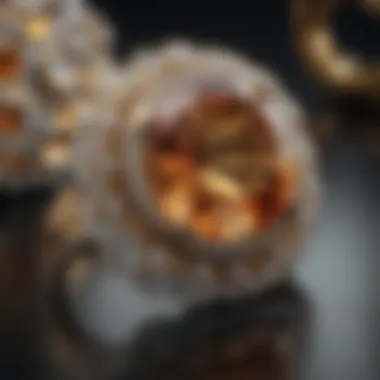
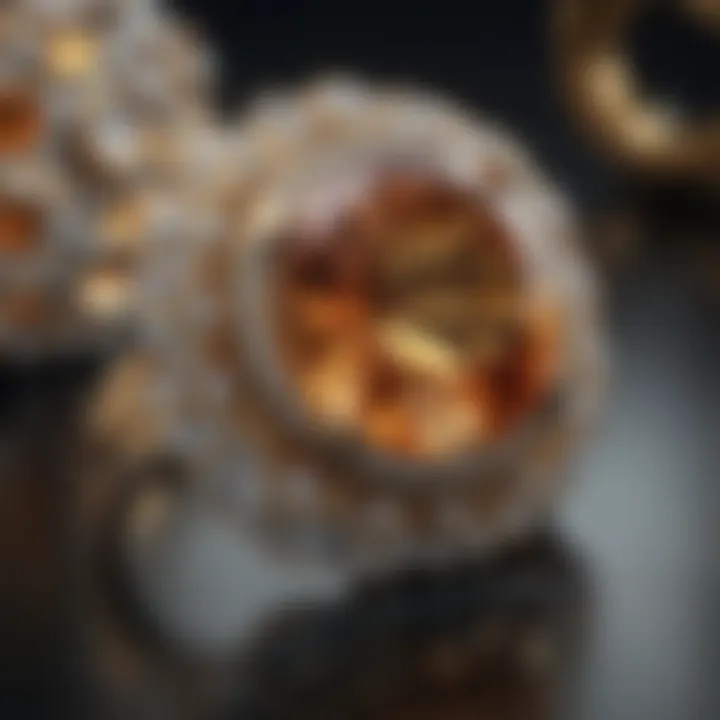
However, while topaz holds its own against wear, it is crucial to note that it can be vulnerable to breakage due to its perfect cleavage. Jewelers need to be careful during cutting and setting to avoid splitting the stone along these lines. In summary, while topaz may be resilient in many respects, it is smart to handle it with care, particularly in settings where it could incur sharp impacts.
Metaphysical Properties of Topaz
Topaz has been revered not just for its stunning beauty but also for its intuitive energy and metaphysical significance. This section delves into the world of topaz's metaphysical properties, resonating with those who believe in the power of gemstones. Topaz is associated with various attributes that can impact both the mind and body, underscoring its importance in the holistic realm.
Healing Properties
Believers hold that topaz holds substantial healing abilities. It’s thought to cleanse the aura, facilitating a sense of peace and calm amidst our chaotic lives. People often find that wearing or holding topaz can help ease emotional disturbances, particularly those stemming from anxiety or depression. It can stabilize emotions and reduce excessive worrying, making it a popular stone among individuals seeking personal growth or emotional balance.
"Topaz is like that comforting friend who knows just when to give you a nudge in the right direction."
Some even suggest using topaz as a tool for manifestations. A common practice involves meditating with the stone to clarify personal goals and desires, fostering a more focused intention to draw desired outcomes into reality. Additionally, physical ailments could be soothed by topaz, as it’s said to benefit the digestive system and bolster metabolism. Many enthusiasts document their experiences of reduced stomach issues while being in the presence of topaz.
Symbolism and Significance
Absorbing the essence of its bright hues, topaz symbolizes strength, wisdom, and wealth, varying subtly across different cultures and beliefs. Traditionally, this gemstone embodies the concept of affection, often seen as a stone of true-love, making it a popular choice for engagement rings. However, its significance doesn’t stop at relationships; topaz is also considered a stone that encourages creativity and clarity of thought.
Each color of topaz conveys distinct meanings. For example, blue topaz symbolizes harmony and communication, making it a favored choice amongst those seeking to enhance their verbal expression or negotiative skills. On the other hand, imperial topaz—known for its warm orangish tones—is believed to promote self-confidence and a zest for life.
In some cultures, the stone is linked to the sun and is believed to bring abundance and good fortune to its owner. The deep connections people have with topaz highlight why it has remained a favored gemstone throughout history.
Embracing its various layers of symbolisms, topaz serves as more than just beauty—it offers a way to connect with deeper self-awareness and enrich life through positivity and clarity.
Topaz in Jewelry
Topaz holds a significant place in the world of jewelry. With its vibrant colors and impressive durability, this gemstone has captured the hearts of many jewelry enthusiasts and designers. In this section, we will explore design trends, types of jewelry featuring topaz, and what makes this gemstone a favorite among collectors and wearers alike.
Design Trends
The world of jewelry design is constantly evolving, and topaz plays an important role in various current trends. From vintage-inspired pieces to sleek contemporary designs, topaz adapts beautifully to diverse styles.
- Color Variety: One major trend is showcasing the range of topaz colors, notably the sought-after blue topaz or the warm golden variety. The contrast of hues within a single piece can make for a striking visual impact.
- Mixed Media: Jewelry designers are increasingly combining topaz with other materials like gold, silver, and even unconventional elements such as wood or resin. This blend provides a fresh twist and encourages broader creativity.
- Customization: Personalization is also a leading trend. Many designers now offer custom pieces where buyers can select their topaz's size, cut, and finish, creating truly one-of-a-kind items that express individuality.
In today's market, the versatility of topaz enables it to fit well within these trends, appealing to a wide range of consumers.
Types of Jewelry Featuring Topaz
Topaz can be found in various types of jewelry, each offering unique appeal and advantages.
Rings
Rings made with topaz have gained popularity for their exceptional ability to combine elegance and durability. A key characteristic of topaz rings is their versatility; they can be fashioned as engagement rings, fashionable statement pieces, or even simple band designs. Topaz rings often stand out due to their lively colors, particularly blue and yellow topaz, which can add a pop of color to any outfit.
- Unique Feature: The impressive hardness rating of topaz makes it an excellent candidate for everyday wear, ensuring elegance without compromising on durability. It’s a fitting choice for customers seeking something long-lasting.
- Advantages: Topaz rings often serve as conversation starters due to their distinctive colors and craftsmanship.
Earrings
Topaz earrings come in various styles including studs, drop earrings, or even chandelier designs. Their shimmering surfaces can catch the light in fascinating ways, drawing attention to the wearer.
- Key Characteristic: One standout property of topaz earrings is their ability to range from delicate to bold, making them suitable for various occasions, whether casual or formal.
- Unique Feature: The lightness of topaz allows for larger styles without being uncomfortable, as their setting can vary from classic to avant-garde.
Necklaces
Topaz necklaces can transform a simple outfit into an intriguing ensemble. Whether in a pendant style or as part of a complex design, these pieces consistently infuse elegance.
- Key Characteristic: The depth of color in topaz necklaces can complement a wide array of necklines, allowing for versatile styling.
- Unique Feature: A standout trait of a topaz necklace is its ability to layer well with other jewelry, creating dynamic looks.
In sum, topaz's presence in rings, earrings, and necklaces solidifies its role in jewelry creation, appealing to clients seeking both beauty and substance. It’s clear that topaz’s charm and adaptability ensure its position as a timeless favorite.
Care and Maintenance of Topaz
Taking good care of topaz is key not just for its beauty, but also for its longevity. Topaz, while tougher than many gemstones, is not invincible. Knowing how to clean and store this stunning gem ensures that it retains its luster and charm for years to come. Additionally, understanding the specific care needs helps avoid pitfalls that could lead to damage or dullness, safeguarding your investment.
Cleaning Techniques
Cleaning topaz requires a gentle touch. First off, avoid aggressive chemicals or hard scrubbing. A simple mix of warm water and mild soap is usually enough. Here’s a step-by-step guide:
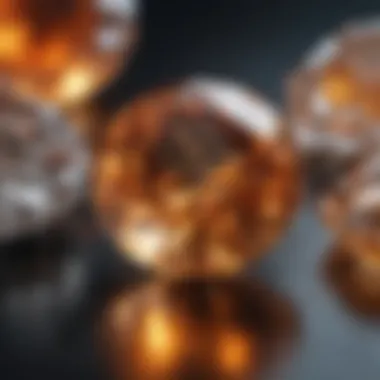
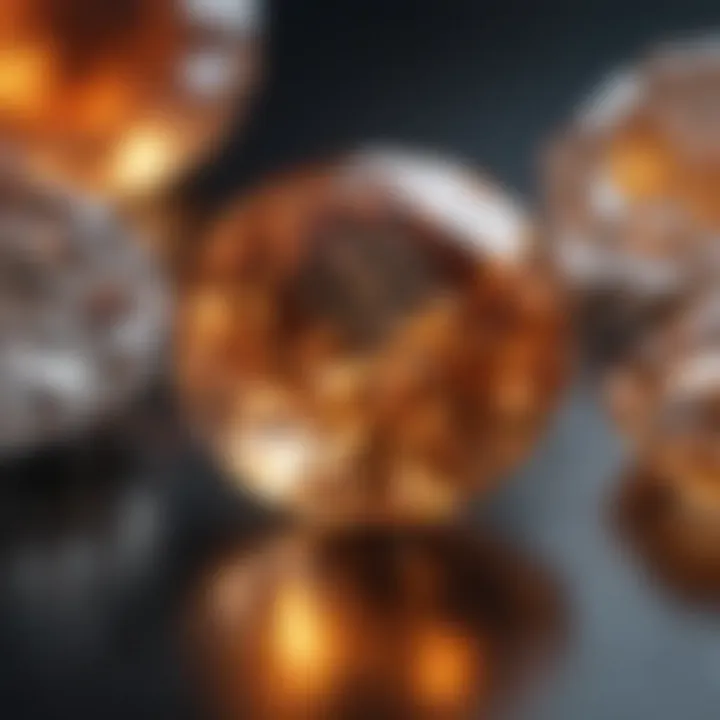
- Mix soapy water: In a bowl, combine warm water with a mild dish soap. Make sure it's not too harsh.
- Soak the topaz: Let your topaz sit in the soapy water for 10-15 minutes. This helps loosen any dirt or grime.
- Use a soft brush: After soaking, take a soft-bristled toothbrush or a cloth. Gently brush the surface to remove any remaining dirt, paying special attention to any intricate settings.
- Rinse well: Rinse the topaz under lukewarm water to ensure all soap is gone. Make sure it’s not too hot!
- Dry properly: Pat dry with a soft cloth. Avoid using paper towels as they may scratch the surface.
"A little care goes a long way in preserving the brilliance of your topaz."
Storage Recommendations
How you store your topaz can make a world of difference in maintaining its condition. Here are some key tips:
- Separate compartments: When placing topaz with other jewelry, it's wise to store it separately. A soft-lined jewelry box with compartments can help prevent scratches from other gems.
- Avoid extreme temperatures: Extreme heat or cold can lead to cracking. A consistent, moderate temperature is best.
- Use pouches or wraps: Consider wrapping topaz pieces in soft cloth or placing them in fabric pouches. This extra layer of protection can save your gemstone from impacts.
- Stay away from sunlight: Long exposure to direct sunlight can fade the colors of some topaz varieties. Store them in a dark place or a jewelry box with a lid.
In essence, taking the time to clean and store your topaz properly can prolong its life and enhance its beauty. Just a little effort goes a long way in keeping your precious stones looking their best.
The Value of Topaz
Understanding the value of topaz is essential, especially for gemstone enthusiasts and collectors alike. By diving into this topic, one can appreciate not only the inherent beauty of this gem but also the intricate factors that determine its price and overall worth in the market. Different variabilities come into play when considering topaz’s value, from its unique physical characteristics to the broader economic factors impacting the gemstone industry.
Factors Influencing Price
Several elements can sway the pricing of topaz, making it an interesting subject for those with a keen interest in gemstones.
- Color: The hue of a topaz stone can make or break its value. While blue topaz is among the most famous, other colors such as pink, yellow, and even the rarer imperial topaz can fetch higher prices. Natural color variations without enhancements generally attract premium pricing.
- Clarity: Like many gemstones, clarity significantly affects the value of topaz. Stones that are virtually inclusion-free are chosen more frequently and command a heftier price tag.
- Cut: The craftsmanship of the gemstone can elevate its appeal. Precise cuts enhance the light and brilliance of topaz, making well-cut stones more valuable.
- Carat Weight: Larger stones are generally more valuable, but this relationship can also vary depending on the other factors mentioned.
- Origin: The geographic source can provide differentiation in value. For instance, topaz from specific notable mines might carry a heavier price based on the deposit's reputation.
"The true worth of any gemstone lies not just in its shine but in the passion and expertise behind its selection and craftsmanship."
Collectible Topaz and Investment Potential
Topaz's attractiveness extends beyond mere beauty; it also showcases potential as a collectible asset. For savvy investors and discerning collectors, this can be quite an enticing avenue.
- Rarity: The value of collectible topaz can soar if certain colors or characteristics are rare. For example, finding true imperial topaz that is vibrant in color can lead to a significant return on investment due to its scarcity.
- Market Trends: Keeping an eye on market trends can give clues about future values. If a particular shade or style is gaining popularity among collectors, investing in that area might yield benefits.
- Historical Significance: Stones tied to historical figures or events can command higher prices. An antique piece featuring topaz, especially if attributed to a significant designer or era, can become a prized possession.
- Certification: Certified gemstones from reliable sources can enhance trust and value. Certification assures buyers of the authenticity and quality, making such pieces more desirable in the marketplace.
Cultural Perspectives on Topaz
Topaz, often regarded as a gem of wisdom and loyalty, carries a rich tapestry of cultural significance across various societies. From ancient civilizations to modern times, this gemstone has been woven into the fabric of different beliefs and traditions. Its beauty transcends mere aesthetics, acting as a bridge between the physical and metaphysical realms. Understanding the cultural perspectives on topaz provides unique insights into its revered status as a birthstone.
Topaz in Literature and Art
The allure of topaz has left an indelible mark on literature and visual arts throughout history. Writers and poets, from Shakespeare to contemporary authors, have referenced topaz in their works, often associating it with themes of clarity, truth, and deep emotional connection. For instance, in some interpretations of the works of William Shakespeare, the color and brilliance of topaz symbolize enlightenment and pure thoughts. The vibrant hues of blue and yellow topaz stir the imagination, demonstrating its ability to inspire creativity among artists.
Visual artists have also embraced topaz’s captivating qualities. Paintings depicting the gemstone often illustrate themes of wealth, enlightenment, and clarity. Artists use topaz to convey emotional depth and intricate narratives, reflecting its beauty and significance in human experience.
"A jewel's hue tells a story, conjures a memory, and enriches a life. Topaz, with its warm tones and shimmering clarity, has stories of its own to whisper."
Cultural references to topaz in songs, poems, and visual art demonstrate how deeply this gemstone resonates within the collective imagination. For many, owning or gifting topaz is not merely about possessing a piece of jewelry, but about embracing its rich cultural heritage.
Topaz in Rituals and Traditions
Across cultures, topaz has found a place in various rituals and traditions, often associated with protection and healing properties. In ancient Egypt, topaz was believed to be a stone of protection, safeguarding individuals from harm and negative energies. This belief was so strong that it was often adorned on amulets worn by pharaohs and other high officials.
In many cultures today, topaz is still used in spiritual rituals and practices. For instance, it's common to see topaz stones present during meditation or energy healing sessions, as practitioners believe it promotes calmness and balances the body's energies. In some traditions, wearing topaz is thought to attract love and prosperity.
The soft, soothing colors of topaz also make it a favored choice during auspicious occasions, such as weddings or anniversaries. Couples often choose topaz as a way to symbolize their commitment and loyalty to each other.
To sum up, topaz remains more than just a birthstone for many; it embodies countless stories, sentiments, and cultural beliefs. It has traveled through time, entwining itself in the traditions that shape societies. Whether through artistic representation or its role in rituals, topaz continues to captivate hearts and minds, reinforcing its standing as a gem of multifaceted significance.
End
The essence of topaz is not merely captured in its vibrant colors and its appeal in jewelry. It embodies a rich tapestry of history, symbolism, and cultural significance that spans across various societies and time periods. This article has navigated through the many facets of topaz, from its geological formation to its metaphysical properties, culminating in understanding why this stone holds such importance, especially for those born in November.
Summarizing the Essence of Topaz
Topaz, with its dazzling array of colors—from the tranquil blues to the luxurious golds—offers something unique and meaningful for every gemstone admirer. Its historical relevance indicates far more than just aesthetic value; it has been revered as a talisman of strength, wisdom, and protection throughout civilizations. Given its hardness, rated an impressive 8 on the Mohs scale, topaz boasts durability that suits everyday wear while remaining a beautiful addition to any ensemble.
The fascinating interplay of natural occurrence and human artistry enhances topaz’s allure in jewelry making. Its versatility allows designers to experiment with shapes and settings that bring out its brilliance. Moreover, the treatments—like irradiation or heat exposure—can transform the stone into an entirely new hue, catering to different tastes and preferences.
"Topaz acts as both a statement piece and an intimate charm, reflecting the spirit of the wearer."
Encouraging Further Exploration of Topaz
For those intrigued by topaz, there’s a world waiting to be explored. Each aspect covered in this article provides a springboard for deeper inquiry and understanding. Whether it’s learning about the geological processes that create this striking stone or delving into its metaphysical beliefs, there’s always more to uncover.
Exploring local gem and mineral shows, visiting shops that specialize in stones, or participating in online gemstone forums, such as those found on reddit.com, offers practical experiences and enhances appreciation. Attending workshops on jewelry making could also deepen your connection to the material, providing hands-on experiences with topaz.
Overall, the journey through the world of topaz is one of personal discovery, enriching knowledge, and appreciating nuances that resonate with each individual. I encourage you to keep researching, engaging, and celebrating this remarkable gem as part of your life or collection. To truly appreciate topaz, you need to see it, feel it, and most importantly, understand its story.



